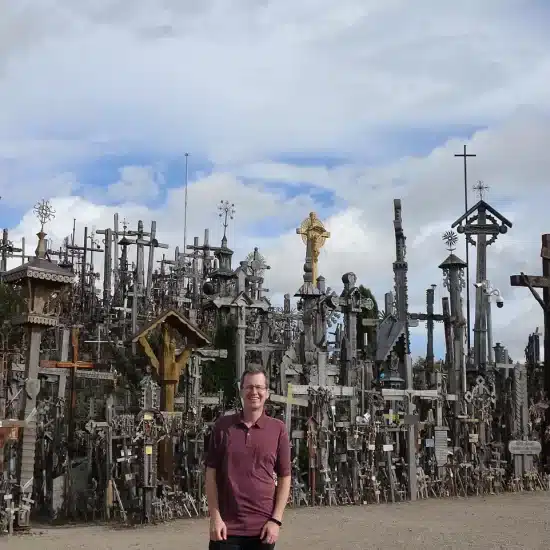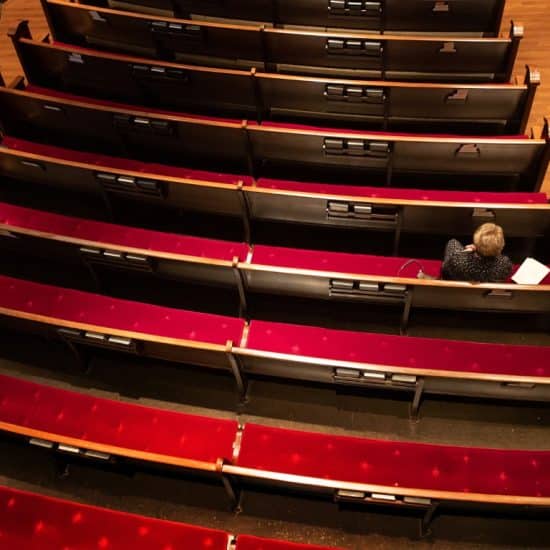The Christian faith presents as its central image a bleeding man dying a cruel death on a Roman cross. We say that this Friday-afternoon misery was the central event in both human and divine history. We most often emphasize that the cross was redemptive — it opened the door to the world’s salvation. But it was also representative — it signifies and represents our human story. And Christians believe it signifies and represents God’s story as well.

David Gushee
|
We live in a cross-shaped world.
I was reminded of this in quite unexpected ways over the weekend in Washington. I was in D.C. with a group of Mercer students who were culminating their class on the Holocaust with me. On Friday we spent the day in the Holocaust Museum. Having been there so many times with students, I decided this time to focus my attention on visual images rather than the familiar text that accompanies those images.
Often I avoid looking at the gruesome images at the beginning and end of the museum. This is video footage shot as the Allied troops liberated the concentration camps: Auschwitz, Buchenwald, Dachau, Bergen-Belsen. It has been a long time since I forced myself to look at the emaciated bodies of both the living and the dead. I was especially horrified to view the footage of the lifeless dead being taken to mass graves, moving in unsettling contortions as they were carried and dragged. It had been a long time since I had looked at such images.
On Friday night I took the students to a Conservative Jewish synagogue in Washington. We were hosted so warmly by the rabbi, who kindly narrated the almost exclusively Hebrew prayer service. After Shabbat dinner, he spent an hour with us answering our questions about Judaism, the Christian-Jewish split in the 1st century, and how Jews view Christianity. He was both honest and gracious. Guards in the parking lot and the entry to the synagogue reminded us that Jewish houses of worship are sometimes targets, even here. Few churches post guards.
Finally on Sunday morning we went to a mass at a Northern Virginia Catholic church. It was Palm Sunday, and the liturgy included a lengthy reading from the Passion story in Mark.
While the story was being read, I was transfixed by the crucifix at the front of the church. Its depiction of Jesus showed a somewhat frail man whose body was contorted very painfully as he endured his suffering. I remembered reading that those who were crucified found it very difficult to breathe. This Jesus looked like he was struggling for breath as he shifted his weight on the cross.
Meanwhile, the Passion story was being read. The Catholic Church has taken great pains since Vatican II to tell the story of the death of Jesus in such a way that all humans, and not just “the Jews,” bear the responsibility for his crucifixion. So when it came time to yell “crucify him,” we all did. But the text also contains its unchanged and unchangeable elements that tell the story of Christ’s death in such a way as to implicate Jewish religious leaders at least as much as Pontius Pilate.
So as I looked upon the cross on Sunday, at one level I saw what most Christians usually see: my beloved Savior, dying for me and for the world. At another level, looking at his contorted, twisted body, I saw the bodies at Auschwitz and Bergen-Belsen, being thrown into their mass graves. Jesus was at that moment being made into yet one more contorted, abused body to add to the massive pile of bodies that have been destroyed in the whole history of humanity.
But I saw Jesus as not just a crucified God, or a crucified human, but a crucified Jew. He was a Jew who suffered at pagan hands. In this sense he was representative of all Jews who have suffered at pagan hands. His contorted body represents all such Jewish bodies, whether at Auschwitz or anywhere else. Jesus’ death represents the historic suffering of the Jewish people.
And often the Jewish people have suffered at Christian hands. And sometimes they have suffered at Christian hands during Holy Week, because of the passions Christians have felt as they have encountered his horrific Passion. So the cross also represents the Jewish experience of persecution at Christian hands — ironically, often in some misplaced attempt to "defend" the Jew killed there.
Christians believe God incarnate died on that cross. So the cross also represents not just the culmination of God’s suffering at human hands but also every particular instance of that suffering — like, for example, when some made in God’s image have killed others made in God’s image, in the name of God.
We do indeed live in a cross-shaped world.
David Gushee is distinguished university professor of Christian ethics at Mercer University.




